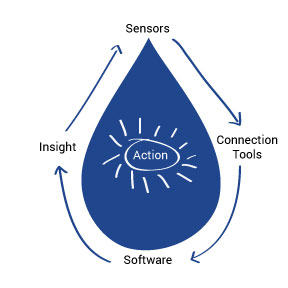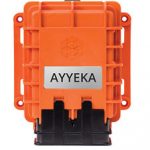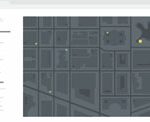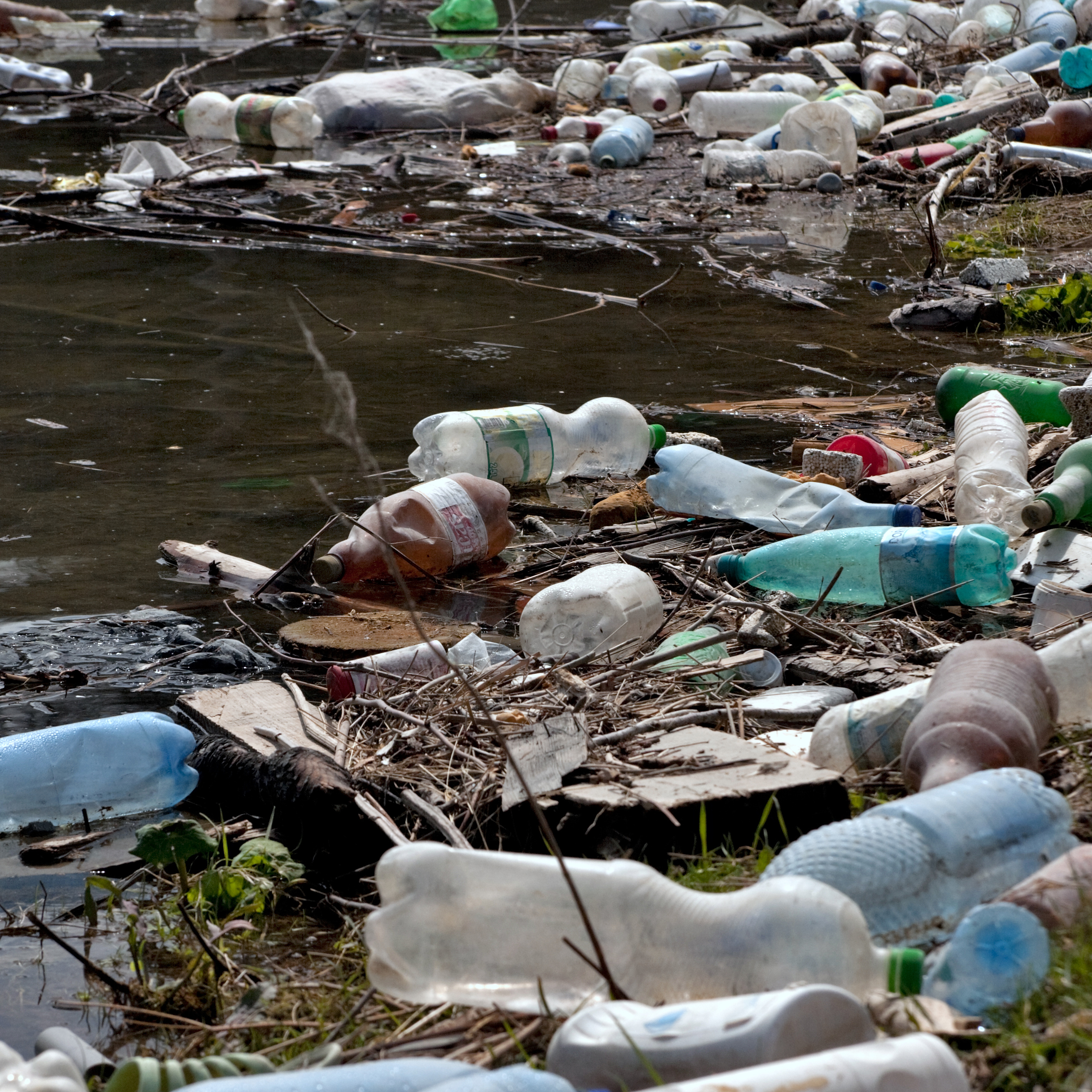A brief survey of IoT wastewater tech at WEFTEC, the world’s largest water quality exhibition in the USA, reveals a rapidly growing interest in industrial IoT (internet of things). Why? Water resource management is key to the security, health and flourishing of human communities.
Concerns around real-time water information (vs. sampling and lab analysis) continue to motivate tech innovators, scientists, and industry engineers who want to prevent pollution and toxic conditions from arising from aging infrastructure, climate change and human/industry underutilized waste products. It’s a scary and exciting time getting things done in H20 space and WEFTEC was a great place to view the latest innovations.

5 innovation areas in the IoT water quality monitoring space:
1. SENSORS 2. CONNECTION TOOLS 3. SOFTWARE 4. INSIGHT 5. ACTION
What we see are two camps of water sensing companies — those trying to be a single-source provider for all 5 areas, and those that are a value-added integration, excelling at one or two areas. You will see giants like Xylem, with many diverse companies in their umbrella, each addressing a branch of these issues with good precision (YSI, for example, making top-notch smart sensors). Or you will see newcomers, like Ayyeka, working to integrate the industry best from the front-end (sensors, connections, software + integration service). Or companies like OptiRTC working exclusively at best at end-chain intelligent software and insight.
6 key features of innovative IoT devices and systems for water quality:
- Accurate, durable and intelligent devices/sensors with long deployment lifespans
- Low-energy, low-power devices across secured networks
- Common standard interface protocols: RS485/232, MODBUS, Wifi, Radio (Bluetooth/LoRa/SIGFOX), Cellular
- RTC (real time control) optional and RTA (real time access)
- Equipment agnostic platforms
- Intuitive, field readable and open source API driven data
Here’s a few companies from WEFTEC 2016 who were promoting these innovations in the water space:

SENSORS: Rugged, real-time, smart sensors that integrate into control systems, work seamless, with low or digital calibration are still a challenge. Many of them require field tech calibration, constant redundancy checks for drift, and are expensive to manufacture. With those factors in mind, here are some reliable companies making smart sensors equipped for IoT integration. For companies interested in building products around sensors, the companies really showing great sensors at WEFTEC are: YSI: EXO1 Multiparameter Sonde, INW: PT2X and Levelscout, Seametrics: JWave Flow meter and Solinst: AquaVent datalogger.
 CONNECTION TOOLS: People need to get data out of sensors and into data analytics software. The issues? Every sensor has unique, complex data parameters and proprietary data output formats. Every site may have different EPA required standards, and there are variable calibration expectations depending on the asset. Mid-level connection tools try to solve these challenges by making transition tools that communicate to multi-parameter sensors, send/interpret their data into analytics through user defined interfaces (hardwire, cell, radio, wifi etc.). Ayyeka: Wavelet Kit, Ciqada module, Hach Sensor Diagnostics are creating different levels of mixed-parameter RTC and device management SCADA systems/networks. At Anuraco, we also focus on getting remote sensors connected, addressing specific challenges in local, low-energy remote networks using self-contained, secure radio tech (Bluetooth Smart, LoRa).
CONNECTION TOOLS: People need to get data out of sensors and into data analytics software. The issues? Every sensor has unique, complex data parameters and proprietary data output formats. Every site may have different EPA required standards, and there are variable calibration expectations depending on the asset. Mid-level connection tools try to solve these challenges by making transition tools that communicate to multi-parameter sensors, send/interpret their data into analytics through user defined interfaces (hardwire, cell, radio, wifi etc.). Ayyeka: Wavelet Kit, Ciqada module, Hach Sensor Diagnostics are creating different levels of mixed-parameter RTC and device management SCADA systems/networks. At Anuraco, we also focus on getting remote sensors connected, addressing specific challenges in local, low-energy remote networks using self-contained, secure radio tech (Bluetooth Smart, LoRa).
 SOFTWARE: For a long time in the non-IoT water world, Excel lead the data wrangling and output field. Now, with the internet revolution and cloud-based software, the data analytics world is teeming with choices of where to put your data. The biggest competitive element is how to let different user levels experience data, so it provides appropriate insight, which leads to correct action and feedback for that user. A water-treatment plant manager needs to extract different kinds of real-time data then a municipal water home consumer. Both want to know if their water is clean and safe. Of the companies at WEFTEC, OptiRTC: a lean, very thought-out scalable set of software platforms, the behemoth Esri, and smaller, locally invested s::can moni::tool were each examples of scalable data analytics for different requirements.
SOFTWARE: For a long time in the non-IoT water world, Excel lead the data wrangling and output field. Now, with the internet revolution and cloud-based software, the data analytics world is teeming with choices of where to put your data. The biggest competitive element is how to let different user levels experience data, so it provides appropriate insight, which leads to correct action and feedback for that user. A water-treatment plant manager needs to extract different kinds of real-time data then a municipal water home consumer. Both want to know if their water is clean and safe. Of the companies at WEFTEC, OptiRTC: a lean, very thought-out scalable set of software platforms, the behemoth Esri, and smaller, locally invested s::can moni::tool were each examples of scalable data analytics for different requirements.
INSIGHT + ACTION : After sensors are deployed and accurate, data is received, read and understood, we are left with the insight and action end of the spectrum. This element is KEY for the success of IoT in H20. Most companies attempting to excel at insight and action, do so by creating large platforms, or single-solution integration services. Here we see some big challenges for smaller companies being able to innovate, as knowledge of the entire system is required to implement action. GE Predix, and Xylem and Hach, each providing full-scale solutions. On the more diverse end, we have great companies doing piece by piece or full-scale like Eijkelkamp Smart Sensing .

Don’t forget here we also have a number of larger projects (not showcased at WEFTEC) hosting open source water data. This data can be integrated into industrial IoT systems (early warning, upstream levels). NOAA open source water data, USGS water data, and prepdata.org are a few of the essentials here. These are worth mentioning, because a number of Software + Insight + Action makes use of these open source data sets and integrate them into their responses at water sites.
Overall, IoT in the water space is building quickly, but is still facing a number of significant challenges around infrastructure flexibility, reliable secure and redundant data networks, and high-level science being translated to basic field action.
Heidi Gustafson is lead project manager at Anuraco, a design company focusing on sensor tech transitions into IoT. Heidi can be reached at heidi@nullanuraco.com.

